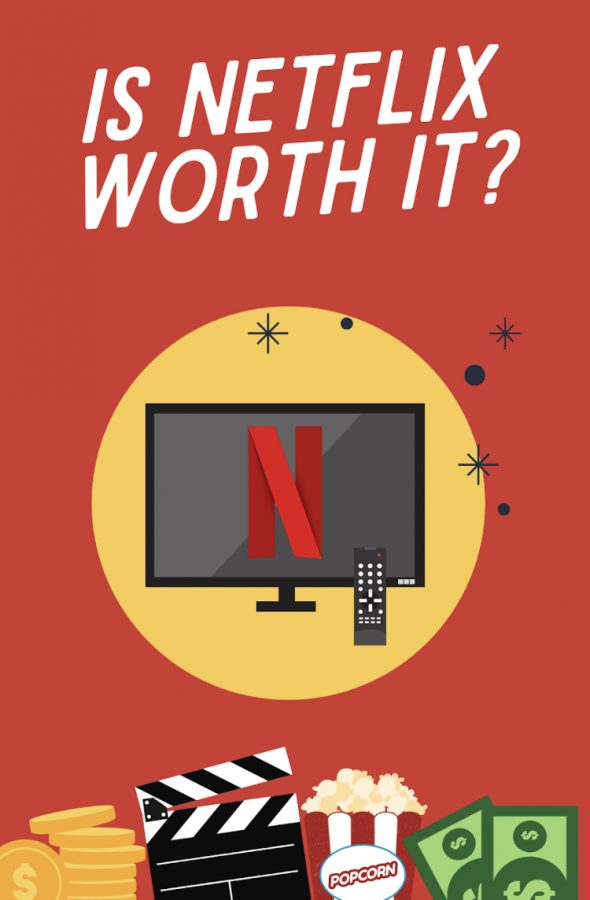FACEOFF: Is Netflix Still Worth it?
January 27, 2021
No (K.P.)
Until about 2018 or 2019, Netflix was the streaming service to have; the cooler, superior older sister of Hulu, HBO Max and all the other subsequent copycats. However, since then, Netflix has steadily declined in quality and value, and most people only keep their subscriptions for nostalgia’s sake, or perhaps because Netflix has considerable cultural cachet — after all, the company has been around since 1997, and has completely ingratiated itself into American society.
The steadily rising cost of Netflix no longer justifies its steadily declining selection of shows. In Jan. 2019, Netflix announced their standard plan would increase from $10.99 to $12.99. A year later, they announced it would increase again, from $12.99 to $13.99. The standard plan now costs more than the premium plan did when it first launched, and does not provide a better viewing experience. How far does Netflix plan on going? How many more price hikes should subscribers tolerate? Many had enough after the first price hike; in July 2019, the company announced its first major loss in U.S. subscribers, forcing it to turn to the international market. With this second price hike, subscribers must again re-evaluate the value of their subscription, which, at this point, amounts to basically nothing.
Just this month, Netflix announced the departure of multiple fan-favorites, including every season of “The Tudors” and the movie “Waco.” While yes, this is par for the course of the streaming industry and Netflix replaces those old titles with new offerings, the truth is, Netflix does not replace what they have lost with content people want to see. It is why I have heard countless friends and family members complain Netflix has nothing good, why this sentiment is echoed across the internet, with countless subreddits and blog posts devoted to the issue.
Additionally, as Netflix’s competitors have gained their footing over the past few years, they have surpassed Netflix itself. With the exception of HBO Max, nearly all the major streaming services cost less: Amazon Prime Video charges between $8.99 and $12.99 a month, while Disney+ charges $6.99 and Hulu charges $5.99. Not only do these services cost less, but they also offer 4K HDR quality for many titles; if you want 4K on Netflix, be prepared to pay for the premium plan, which costs a whopping $17.99 — three times the cost of Disney+.
Netflix, recognizing that its competition has outpaced it, has tried to differentiate by producing original content. But the others have caught on: now everyone produces original content, once again making a Netflix subscription pointless (unless you find paying nearly $14 a month for “The Kissing Booth” worth it).
Netflix subscribers need to take a close look at why they still pay up to $18 a month for a limited, dwindling selection of low-quality shows. I suspect that most will find it is purely based on emotional attachment — an unwillingness to let go from a company once so relevant and omnipresent.
Yes (G.H)
In the realm of streaming networks, Netflix reigns supreme, reporting last week that they passed an impressive 200 million subscribers according to Consumer News and Business Channel. While 2020 saw the introduction of countless competitors — from NBCUniversal’s Peacock to Discovery+ and HBO Max — Netflix continues to hold its grip on society due to its unmatched features, low pricing relative to cable and original series.
Featuring no commercials unlike streaming competitors such as Hulu and Peacock, streaming in over 190 countries out of the U.S. (as opposed to HBO Max, Hulu, Peacock and Disney+ ), offering the ability to download content and soon adding a shuffle play option based on their comprehensive viewer algorithm, Netflix hosts the most advanced features of any streaming network available.
Netflix continuously produces pop-culture hits, from temporarily distracting users from the coronavirus pandemic with Tiger King, to making thousands of teenagers wish they lived on the coast of Outerbanks and now transporting millions of users to the regency era with Bridgerton. The latest from Shonda Rhimes, Bridgerton, broke records as the most-watched series premiere to date, with 63 million households tuning in, according to Yahoo Finance. These acclaimed original series and movies exclusive to the network serve to empower it as arguably the best service. In 2021, the service is slated to release 70 original movies according to Bloomberg, greatly expanding their selection.
While more expensive than some other competitors, the diversity in selection that Netflix hosts within its own original collection makes the price tag bearable. The company also plans to expand its available foreign language series in 2021. With the success of originals such as Lupin, a French-language heist (watched by more than 70 million accounts within its first four weeks of release according to Cnet) and the fourth season of La Casa de Papel (watched by around 65 million accounts in its first four weeks), these shows have proved to have a dedicated base. The variety of foreign shows, which other services lack, also increases its appeal to a broader selection of users.
According to Consumer Reports, during 2020, the price for a basic TV package increased from $30 to $35 per month, making Netflix’s standard plan of $14 a month a little less than half of the hefty price tag cable television demands. Given the wide array of content and enticing features unmatched by other services, one should not expect to see many Netflix users ditching the classic service anytime soon.









